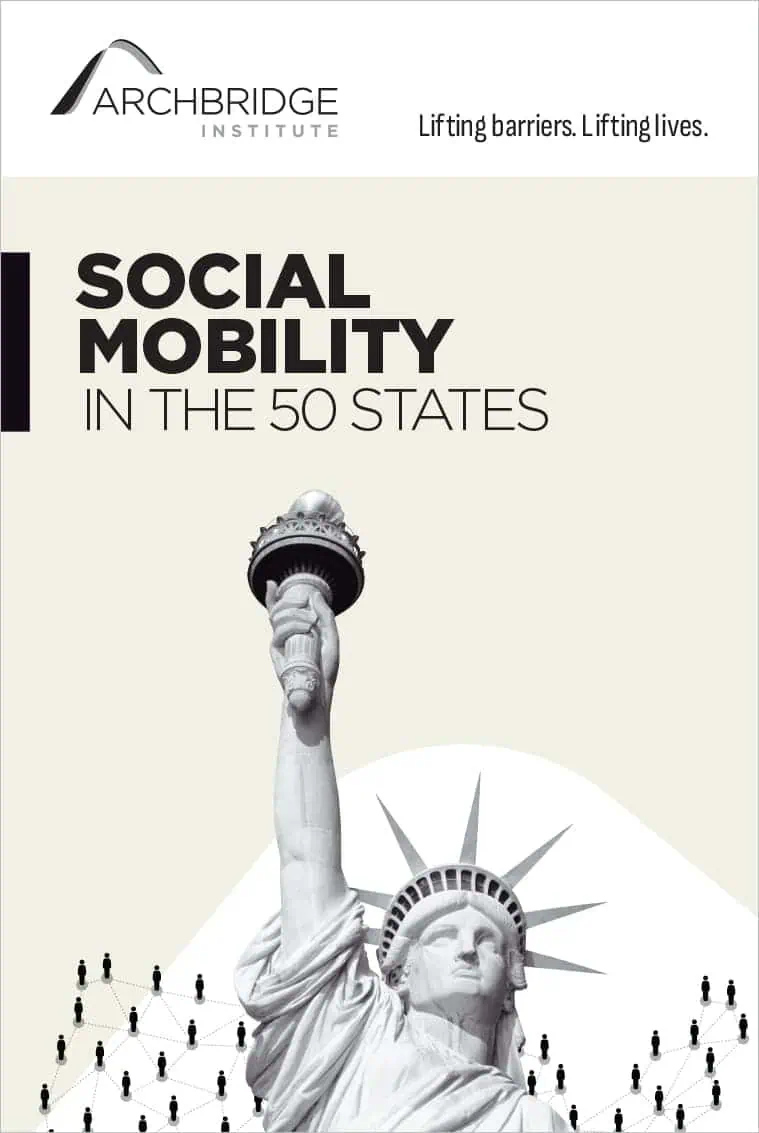
Executive Summary
The conventional wisdom—both outside and inside the research community—is that if someone wants to achieve the “American Dream” of upward mobility, she should move to Canada or Scandinavia. However, this conclusion is largely based on research that conflates rising income inequality with immobility from one’s parental income position. These studies mistakenly claim to be assessing “relative mobility”—the link between parent and child ranks—but are actually about “absolute mobility” (the link between parent and child income levels). Following Chetty et al. (2014), a number of recent studies have focused on true measures of relative mobility, and many newer studies have found less mobility in countries outside the US than the earlier research. In addition, too many conclusions about the US’s comparative standing in terms of intergenerational mobility have failed to differentiate between, for example, male earnings mobility and family income mobility.
This report—Part Two of a three-part primer on economic mobility in the US—reassesses the cross-national evidence on intergenerational economic mobility, updating previous conclusions by reviewing more recent research and reevaluating the older literature. While it affirms much of the conventional wisdom about cross-national comparisons, it highlights previously neglected nuances in the literature that complicate the simple conclusion that the fates of American children are more tied to their family circumstances than is true of children in other countries. Various difficulties measuring intergenerational mobility introduce a significant amount of imprecision in making cross-national mobility comparisons.
Among the Findings
In terms of relative mobility, American sons and daughters appear about as mobile in the US as in other countries when their earnings are compared with those of their fathers.
- The best-developed literature on relative mobility (comprising 25 studies involving countries outside the US) compares fathers’ and sons’ earnings. American men with fathers in the bottom quarter, fifth, or tenth of earnings are about as likely as their international counterparts to see upward mobility out of the bottom as adults (based on 18 studies involving countries outside the US). Downward earnings mobility from the top is not obviously lower among American men than it is for sons in other countries. While the evidence is not dispositive, these conclusions are supported by research using harmonized methods and data to compare countries and are reinforced by multiple single-nation studies.
- Similarly, research estimating the intergenerational rank association (IRA) for male earnings indicates, at worst, only modestly lower mobility in the US than in Norway, Sweden, Finland, and Canada, with Denmark perhaps higher than all of them. The differences that turn up across these studies—12 of which involve countries outside the US—may simply reflect methodological challenges afflicting mobility and cross-national research.
- American daughters also experience comparable mobility to their international counterparts if their earnings are compared to those of their fathers. Seven studies estimate upward and downward mobility for countries other than the US, and the US appears to have roughly the same mobility as do the Scandinavian nations (and probably Great Britain).
- Just three studies include father–daughter earnings IRAs for countries outside the US, but they suggest that mobility is the same in the US, Norway, Sweden, and Italy.
However, when sons’ and daughters’ outcomes are compared with parental family income instead of father earnings, the US has lower relative mobility than other countries (particularly lower upward mobility).
- Comparing parental family income to sons’ earnings, individual income, or family income (15 studies involving countries outside the US), American men raised at the bottom appear more likely to end up in the bottom as adults than men in Canada, Norway, Sweden, Finland, and Denmark.
- Among men raised at the top of the distribution of parental income, Americans seem more likely to be at the top of the distribution themselves than are Canadians. But they appear no more likely to remain at the top than men in Scandinavia (or, perhaps, Great Britain and West Germany).
- There is only one study using harmonized data and methods that reports IRAs comparing parental family income to sons’ earnings or individual income. A small literature assesses single countries in isolation. The limited evidence (based on three studies of the US, four studies of Sweden, and eight of other countries outside the US) suggests less mobility in the US than in Scandinavia, Canada, or Italy. Great Britain may have mobility as low as or lower than in the US. The sparse evidence comparing the family incomes of parents and sons (four studies involving countries outside the US) suggests that the US has a higher IRA (lower mobility) than Norway, Sweden, West Germany, and Canada. A fifth study indicates higher family income mobility in Australia than in the US, pooling sons and daughters.
- American daughters also may have less upward and downward mobility than Sweden, Finland, and Canada when family incomes are compared, but that conclusion is based on just one study for each of those countries.
- Comparing daughter’s earnings or family income to parent family income, Americans have lower mobility (a higher IRA) than their counterparts in Norway, Sweden, West Germany, and Canada. There are just seven studies of IRAs comparing parental income to daughter outcomes that involve countries outside the US.
- An important caveat is that research by Landerso and Heckman (2016, 2017) suggests that American IRAs are significantly lower when years without parental family income or child earnings are excluded from averaging. The entire gap in the Danish–US IRA looking at child earnings or child pre-tax and -transfer income disappears after dropping these years.
Absolute mobility patterns in the US reduce childhood inequalities less than absolute mobility patterns in other countries. However, some cross-national differences have been overstated by earlier studies.
- As discussed in Part One of this primer, summary measures such as the intergenerational elasticity (IGE), intergenerational correlation (IGC), and the sibling correlation are conventionally, but wrongly, thought to summarize relative mobility. In fact, they summarize absolute mobility; they depend not only on relative mobility (changes in rank) but on changes in the cross-sectional distribution of incomes between generations.
- The IGE summarizes the extent to which childhood absolute income inequalities are reduced in adulthood as a result of the absolute mobility patterns of poor, middle-class, and rich children. A higher IGE indicates that the pattern of absolute mobility reduces childhood income inequalities less in percentage terms.
- The US has a higher male earnings IGE than Canada, Norway, Sweden, Finland, and Denmark, and there is no reason to think that it has a lower IGE than West Germany, Great Britain, Australia, or Italy. There are 65 studies involving IGEs from outside the US. In the US, absolute childhood inequalities decline less in percentage terms by adulthood than they do in other nations. That said, previous reviews (e.g., Corak, 2016) have overstated the extent to which the US lags other countries.
- IGE studies comparing parental family income to sons’ earnings or family income are rarer (28 involving countries outside the US) and suffer from limitations, but they also show the US having a higher IGE than other countries (Canada, Great Britain, Norway, Sweden, Finland, Denmark, and West Germany). These are reinforced by studies that pool sons and daughters (10 studies involving non-US countries).
- Comparing father and daughter earnings, the US has a higher IGE than Canada and Scandinavia. Comparing parental family income to daughter earnings or family income, the US IGE is larger than in Scandinavia but not necessarily Great Britain. In total, there are 28 studies involving daughter IGEs outside the US.
This conclusion holds even if we disregard intergenerational changes in the cross-sectional dispersion of income
- The intergenerational correlation (IGC) indicates the extent to which absolute mobility patterns reduce childhood inequalities in adulthood after factoring out the change in the standard deviation of income between generations. It still reflects dollar changes (in percentage terms) rather than only rank changes.
- There are 20 studies estimating male earnings IGCs for countries outside the US. The US has a higher IGC (less reduction of childhood inequalities by adulthood) than the Scandinavian countries, though the evidence is less clear in comparison to Canada, Great Britain and West Germany.
- Comparing parental family income to sons’ earnings, individual income, or family income, the US has a higher IGC than Norway, Sweden, Finland, and Canada, but it is unclear whether Great Britain’s IGC is lower than in the US. Eleven studies involving countries outside the US are included in this analysis, five of which involve only Great Britain.
- Only eight studies estimate IGCs for daughters outside the US. Reliable conclusions cannot be drawn about how the US compares with other countries on this dimension of mobility.
- Similarly, only three studies estimate IGCs outside the US pooling sons and daughters. It is not possible to draw reliable comparative conclusions from this research.
The limited research examining how strongly siblings’ incomes are correlated—another measure of absolute mobility—suggests that family influences affect child incomes more in the US than in Scandinavia.
- Sibling correlations indicate the extent to which shared influences affect siblings’ incomes. They depend on the IGC but also on the relationship between other shared influences and grown-child income. (In Part One of this primer, I estimate sibling rank correlations, which are summary measures of relative mobility.)
- Only 13 studies estimate brother correlations for countries outside the US, 12 of them involving only Scandinavian countries. The US has more similarity between siblings’ incomes than those nations, and possibly more than West Germany.
- Just eight studies estimate sister correlations for countries outside the US, seven of them involving only Scandinavian countries. The limited evidence suggests lower mobility in the US than in Scandinavia, but higher mobility than in West Germany.
Research on some kinds of intergenerational mobility is practically non-existent.
- There are no studies of countries outside the US that examine what is perhaps the best measure of intergenerational mobility: sibling rank correlations. There are practically no such studies of the US either.
- Outside the US, the research assessing how likely children are to exceed parental income is confined to a single study of Canada. There do not appear to be significant differences between Canada and the US on this indicator.
The cross-national research on educational and occupational mobility does not consistently show that the US trails other countries, though a number of studies suggest that the relationship between parental education or income and child outcomes (including test scores) is stronger in the US than elsewhere.
This report makes clear that the question of whether Americans are more closely tied to their parental origins than are residents of other nations is much more complicated than believed by commentators, researchers, and even mobility researchers. The better standing of the US versus other countries in terms of relative earnings mobility—as contrasted with its worse standing in terms of relative family income mobility—may also point to cross-national differences in marriage and single parenthood as drivers of family income mobility differences. That hypothesis is consistent with the finding that the US looks worse primarily in terms of upward mobility from the bottom—rather than downward mobility from the top—when using parental family income.
Scott Winship, PhD, is a senior fellow and director of the Center on Opportunity and Social Mobility at the American Enterprise Institute. He serves as an academic advisor for the Archbridge Institute. Follow his work @swinshi.





